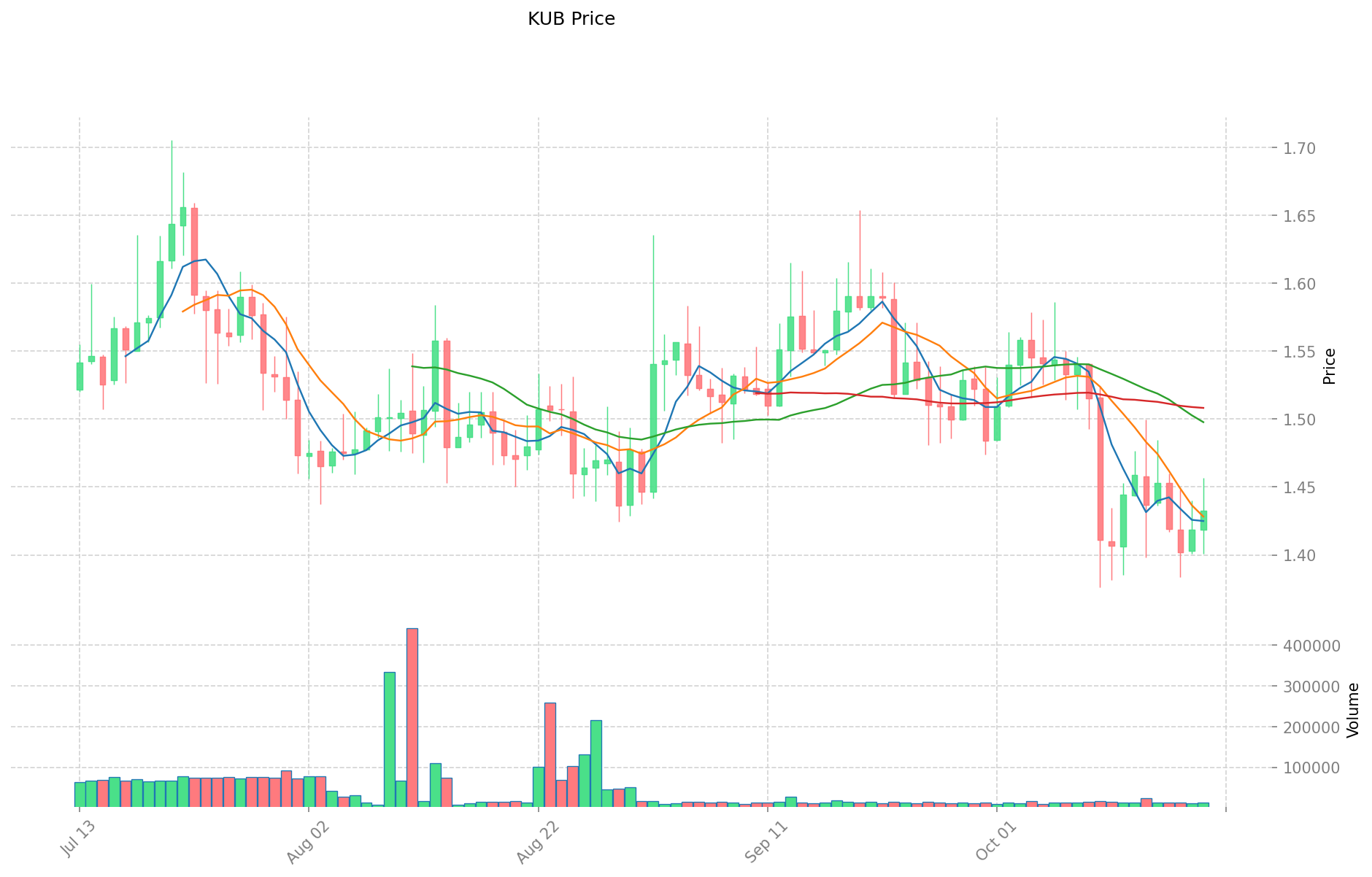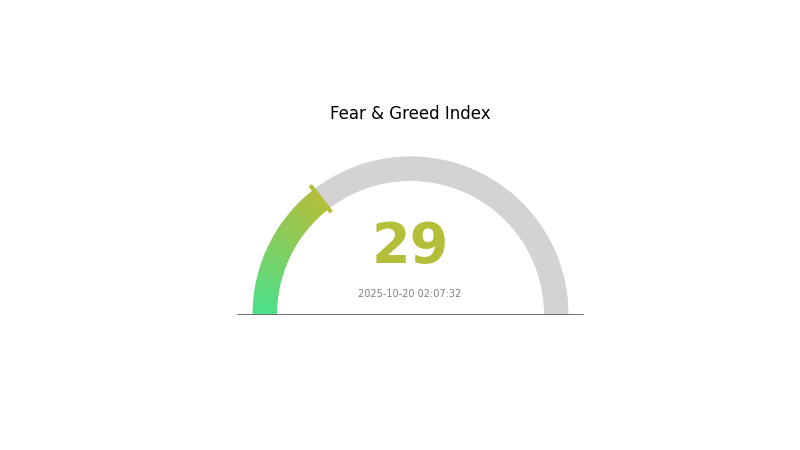2025 KUB Price Prediction: Analyzing Market Trends and Potential Growth Factors for KuCoin Token
Introduction: KUB's Market Position and Investment Value
KUB Coin (KUB), as the native and utility token of the Bitkub Chain ecosystem, has established itself as a key player in the blockchain infrastructure space since its inception. As of 2025, KUB's market capitalization stands at $127,286,510, with a circulating supply of approximately 88,850,000 tokens and a price hovering around $1.4326. This asset, often referred to as the "fuel of the Bitkub ecosystem," is playing an increasingly crucial role in powering decentralized applications and facilitating transactions within the Bitkub Chain network.
This article will provide a comprehensive analysis of KUB's price trends from 2025 to 2030, taking into account historical patterns, market supply and demand, ecosystem development, and macroeconomic factors to offer professional price predictions and practical investment strategies for investors.
I. KUB Price History Review and Current Market Status
KUB Historical Price Evolution
- 2021: KUB launched, price reached an all-time low of $0.381968 on July 20
- 2021: Reached all-time high of $17.24 on December 28, marking significant growth
- 2025: Price has declined to $1.4326, representing a 91.69% drop from ATH
KUB Current Market Situation
As of October 20, 2025, KUB is trading at $1.4326. The coin has seen a 1.21% increase in the last 24 hours, but shows declines across longer time frames. It's down 2.53% over the past week, 9.6% over the last month, and a substantial 39.55% over the past year. KUB's market cap stands at $127,286,510, ranking it 363rd in the cryptocurrency market. With a circulating supply of 88,850,000 KUB out of a total supply of 110,000,000, the coin has a circulation ratio of 80.77%. The current market sentiment for cryptocurrencies is cautious, with the fear and greed index indicating "Fear" at a value of 29.
Click to view the current KUB market price

KUB Market Sentiment Indicator
2025-10-20 Fear and Greed Index: 29 (Fear)
Click to view the current Fear & Greed Index
The crypto market sentiment remains cautious as the Fear and Greed Index sits at 29, indicating a state of fear. This suggests investors are hesitant and risk-averse, potentially creating buying opportunities for contrarian traders. However, it's crucial to conduct thorough research and risk assessment before making any investment decisions. The current market climate may present both challenges and possibilities for strategic investors in the KUB ecosystem.

KUB Holdings Distribution
The address holdings distribution data for KUB reveals a unique market structure. This metric provides insights into the concentration of token ownership across different addresses on the blockchain.
Based on the provided data, it appears that there is no significant concentration of KUB tokens in any particular addresses. This suggests a relatively decentralized distribution of KUB holdings among network participants. Such a distribution pattern is generally considered favorable for market stability and resilience against potential price manipulation by large holders.
The lack of highly concentrated holdings may indicate a healthier market structure for KUB, potentially reducing the risk of sudden price swings caused by the actions of a few large holders. This decentralized ownership structure could contribute to more organic price discovery and potentially lower volatility in the KUB market.
Click to view the current KUB Holdings Distribution

| Top | Address | Holding Qty | Holding (%) |
|---|
II. Core Factors Affecting KUB's Future Price
Technical Development and Ecosystem Building
- Ecosystem Applications: KUB is the native token of the Bitkub Chain ecosystem, which hosts various DApps and projects.
III. KUB Price Prediction for 2025-2030
2025 Outlook
- Conservative prediction: $1.17 - $1.43
- Neutral prediction: $1.43 - $1.70
- Optimistic prediction: $1.70 - $1.96 (requires favorable market conditions)
2026-2027 Outlook
- Market phase expectation: Potential growth phase
- Price range forecast:
- 2026: $1.61 - $1.80
- 2027: $1.69 - $2.31
- Key catalysts: Increased adoption and potential technological advancements
2028-2030 Long-term Outlook
- Base scenario: $2.02 - $2.32 (assuming steady market growth)
- Optimistic scenario: $2.35 - $2.50 (with accelerated adoption and favorable market conditions)
- Transformative scenario: $2.50+ (with breakthrough innovations and widespread integration)
- 2030-12-31: KUB $2.50 (potential peak based on current projections)
| 年份 | 预测最高价 | 预测平均价格 | 预测最低价 | 涨跌幅 |
|---|---|---|---|---|
| 2025 | 1.96321 | 1.433 | 1.17506 | 0 |
| 2026 | 1.79999 | 1.69811 | 1.6132 | 18 |
| 2027 | 2.30874 | 1.74905 | 1.69658 | 22 |
| 2028 | 2.35352 | 2.0289 | 1.21734 | 41 |
| 2029 | 2.45415 | 2.19121 | 1.2709 | 52 |
| 2030 | 2.50849 | 2.32268 | 2.253 | 62 |
IV. Professional Investment Strategies and Risk Management for KUB
KUB Investment Methodology
(1) Long-term Holding Strategy
- Suitable for: Patient investors with a high risk tolerance
- Operation suggestions:
- Accumulate KUB during market dips
- Set price targets for partial profit-taking
- Store KUB in a secure hardware wallet
(2) Active Trading Strategy
- Technical analysis tools:
- Moving Averages: Use to identify trends and potential reversal points
- RSI (Relative Strength Index): Monitor overbought/oversold conditions
- Key points for swing trading:
- Set stop-loss orders to limit potential losses
- Take profits at predetermined resistance levels
KUB Risk Management Framework
(1) Asset Allocation Principles
- Conservative investors: 1-3% of crypto portfolio
- Aggressive investors: 5-10% of crypto portfolio
- Professional investors: Up to 15% of crypto portfolio
(2) Risk Hedging Solutions
- Diversification: Spread investments across multiple cryptocurrencies
- Stop-loss orders: Implement to limit potential losses
(3) Secure Storage Solutions
- Hardware wallet recommendation: Gate Web3 Wallet
- Software wallet option: Official Bitkub Chain wallet
- Security precautions: Always enable two-factor authentication and use strong, unique passwords
V. Potential Risks and Challenges for KUB
KUB Market Risks
- High volatility: KUB price can experience significant fluctuations
- Limited liquidity: May face challenges in executing large trades
- Competition: Other blockchain platforms may outperform Bitkub Chain
KUB Regulatory Risks
- Uncertain regulatory environment: Potential for unfavorable regulations in key markets
- Compliance challenges: Changing legal requirements may impact KUB's utility
- Cross-border restrictions: International regulations may limit KUB's global adoption
KUB Technical Risks
- Smart contract vulnerabilities: Potential for exploits in the underlying code
- Scalability issues: Bitkub Chain may face challenges in handling increased network load
- Interoperability limitations: Difficulty in integrating with other blockchain ecosystems
VI. Conclusion and Action Recommendations
KUB Investment Value Assessment
KUB offers potential as a utility token within the Bitkub Chain ecosystem, but faces significant competition and regulatory uncertainties. Long-term value depends on Bitkub Chain's adoption and technological advancements, while short-term risks include high volatility and limited liquidity.
KUB Investment Recommendations
✅ Beginners: Consider small, long-term positions after thorough research
✅ Experienced investors: Implement dollar-cost averaging and set clear exit strategies
✅ Institutional investors: Conduct comprehensive due diligence and consider KUB as part of a diversified crypto portfolio
KUB Trading Participation Methods
- Spot trading: Purchase KUB on Gate.com
- Staking: Participate in KUB staking programs for potential passive income
- DeFi integration: Explore decentralized finance opportunities within the Bitkub Chain ecosystem
Cryptocurrency investments carry extremely high risks, and this article does not constitute investment advice. Investors should make decisions carefully based on their own risk tolerance and are advised to consult professional financial advisors. Never invest more than you can afford to lose.
Share
Content